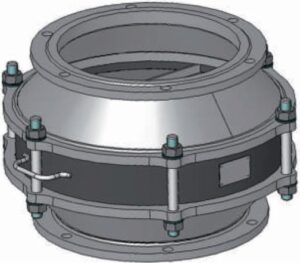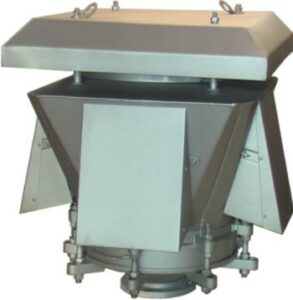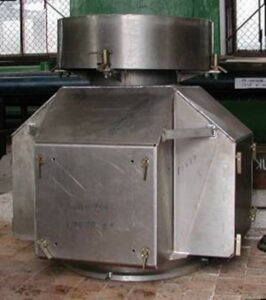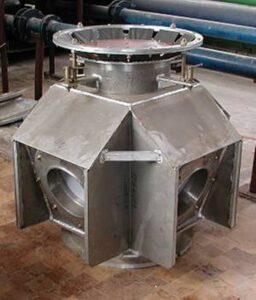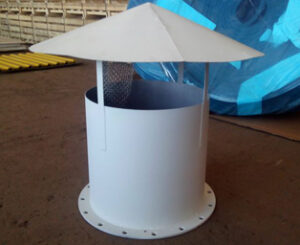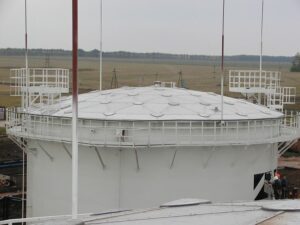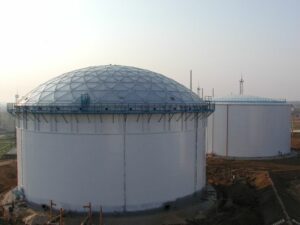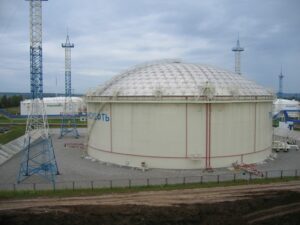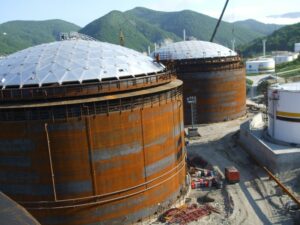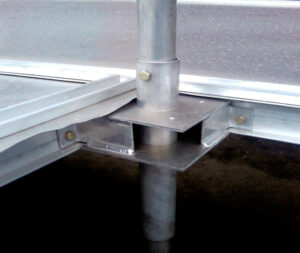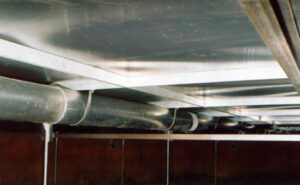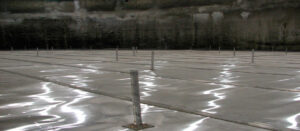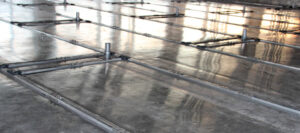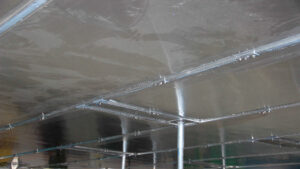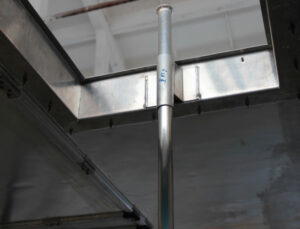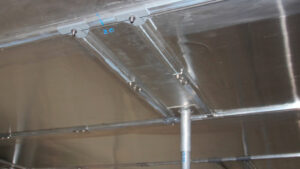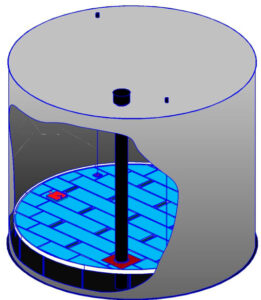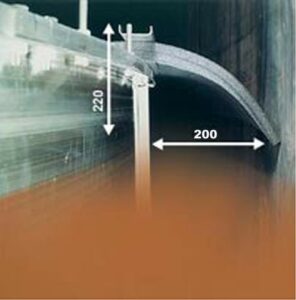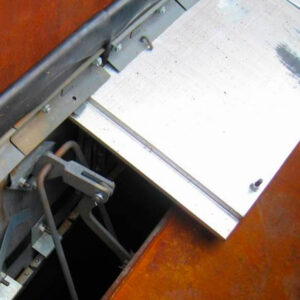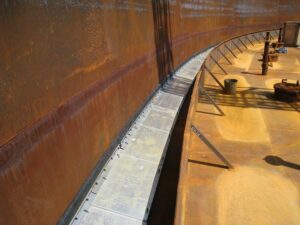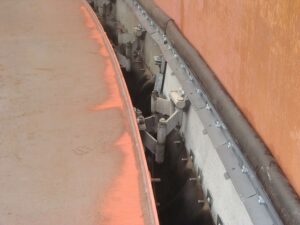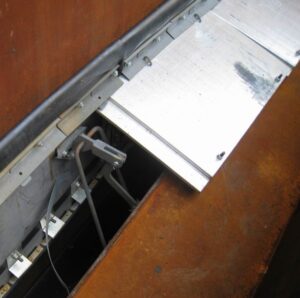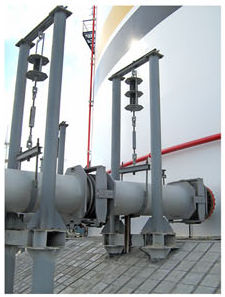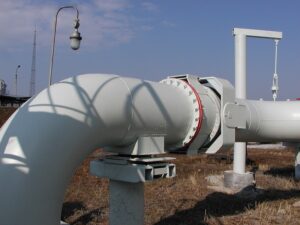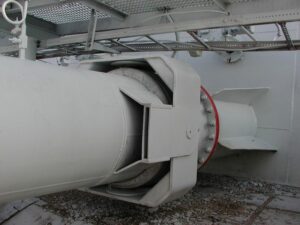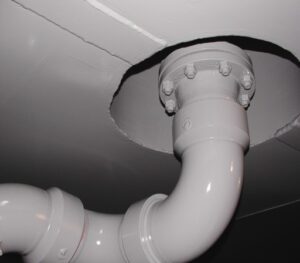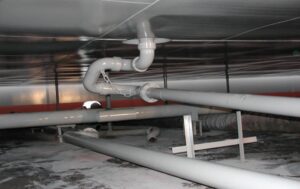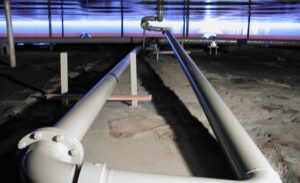Equipment for tanks, spare parts parts, components
Fire fuses
Fire fuses PO are manufactured according to Technical Specifications TU 3689-024-12739584-2006.
Fire safety fuses are designed to prevent flame from penetrating into a tank with oil and petroleum products. The software is installed with elements of tank technological equipment.
Fuses consist of a housing and a flame-extinguishing element – a cassette. In the PO-50 fuse, the cassette is built into the housing. The cassette consists of flat and corrugated aluminum alloy tapes wound in alternating layers around an axle.
The ability of the cassette to localize a flame is ensured by the size of the narrow vertical channels formed between the flat and corrugated tapes, and is based on the principles of heat transfer from the gas flow to the walls of the cassette channels. In this case, the temperature of the gas flow is reduced to safe limits.
The assigned service life is 5 years.
Note. After 5 years of operation, fire arrester cassettes must be replaced with new ones or tested for throughput and explosion-proofness on special stands, with a mandatory note in the operating manual, to assess their technical condition and determine the possibility of further operation.
Fuses of other standard sizes (PO-100, PO-150, PO-200, PO-250, PO-350, PO-500) consist of a collapsible housing – two adapters, between which is placed a fire arrester cassette, consisting of flat and corrugated aluminum tapes alloy, wound in alternating layers on the axle, and laid in the shell. The tape is secured in the body by straps to prevent movement.
Breathing valves
Breathing valves KDS2-1500 and KDS2-3000 are manufactured according to Technical Specifications TU 3689-006-12739584-2000.
The KDS breathing valve is designed to seal the gas space of tanks with oil and petroleum products and regulate the pressure in this space within specified limits.
The valves operate in both breathing and safety modes. When installing breathing valves on a tank as safety valves, the latter must be of the same size as the breathing valves and set to higher parameters of excess pressure and excess vacuum.
Corrosion-resistant aluminum alloys are used as the main materials in the valve design. Synthetic materials that are chemically resistant to stored petroleum products are used as sealing elements and gaskets.
The valve design allows for the possibility of replacing the fire arrester cassette without dismantling the valve.
At the Customer’s request, the valves can be equipped with adapters for DN150, DN200, DN250, DN350 and DN500.
Tank ventilation pipes
Tank ventilation pipes PV are produced according to Technical Specifications TU 3689-008-12739584-02. This product is certified – certificate of conformity RU C-RU.MH10.B.00387.
PV ventilation pipes are designed for ventilation of the space above the pontoon in steel vertical tanks equipped with a pontoon, type RVSP, in order to eliminate the formation of an explosive gas-air mixture and ventilation of the gas space of tanks without a pontoon, type RVS.
We manufacture and sell:
- For ventilation of the gas space of tanks with a pontoon (RVSP) and without a pontoon (RVS): PV-150, PV-200, PV-300, PV-350, PV-500;
- For ventilation of the space above the pontoon in tanks with a pontoon (RVSP): PV-500-O, PV-500-P, PV-500-PM, PVR-Ts-500.
Aluminum dome roofs for pontoon tanks
Aluminum dome roofs are manufactured in accordance with the KM project and Technical Specifications TU 3689-012-12739584-2004. This product is certified – certificate of conformity RU C-RU.MH10.B.00386
The aluminum dome roof is equipped with all the necessary equipment for operating the tank.
Aluminum alloys have been used in building structures for more than 40 years; they are close to steel in strength and have almost 3 times less weight. Aluminum alloys have increased corrosion and cold resistance.
The dome roof is designed for a specific Customer, taking into account the characteristics of each tank and local meteorological conditions (snow and wind loads, seismicity).
Reliability indicators:
Service life – at least 50 years.
The time between repairs is at least 20 years.
Corrosion – absent.
Strength characteristics are ensured by carrying out strength calculations when performing a detailed design using a certified calculation program (design and computing complex Strukture CAD for Windows (SCAD).
The aluminum dome roof is a mesh structure consisting of a frame and deck. The frame beams are connected at the nodes by means of upper and lower plates.
The connection of the frame elements, as well as the decking with the frame, is carried out without welding, using bolted and screw connections, which is technologically advanced in terms of installation, and if it is necessary to install the roof on another tank, it can be dismantled.
The design of the aluminum dome roof allows its installation inside the tank without the use of a special installation platform.
Aluminum dome roofs for tanks without pontoon
The production of aluminum sealed dome roofs for tanks is carried out according to Technical Specifications TU 3689-012-12739584-2004 with separate sending units and parts that are assembled into the product at the installation site.
In order to improve tanks for oil and petroleum products, sealed aluminum dome roofs have been developed.
The sealed aluminum roof structure is the prototype of the ventilated aluminum dome roof. The difference is that the roof deck, with a thickness of at least 4 mm, is fully welded (sealed), and is attached only to the peripheral ring of the tank, which ensures an explosion-proof roof structure.
The sealed aluminum roof is equipped with all the necessary equipment for operating the tank, including breathing fittings.
The first sealed aluminum dome roofs in production were made for RVS-1000 tanks (D=10.43 m) of Railways OJSC. The first roof was installed on the diesel fuel tank of the Murom station fuel warehouse in the Vladimir region. In total, 4 such roofs were manufactured for the facilities of Railways, one of which will be installed at the same station, and the other two at the Taksimo station in the Irkutsk region.
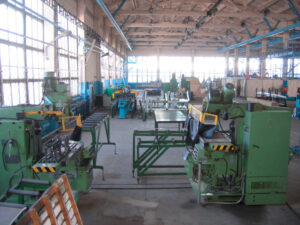
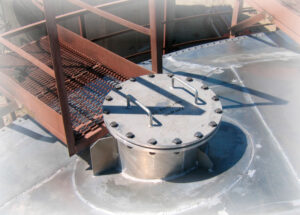
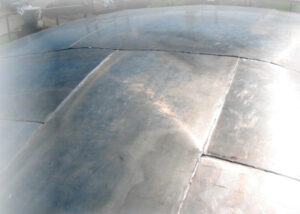
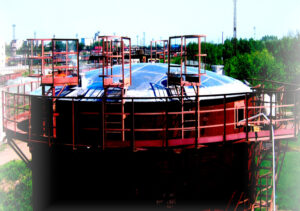
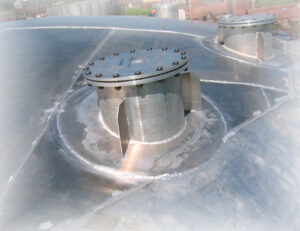
Aluminum float type pontoons
The production of aluminum pontoons “ALPON” for tanks is carried out according to Technical Specifications TU 3689-004-12739584-98 with separate sending units and parts that are assembled into the product at the installation site.
This product is certified – certificate of conformity RU C-RU.MH10.B.00320. The products are included in the register of the main types of products – registration number 20108-1228-0746.
An aluminum pontoon is a simple and effective means of reducing losses from the evaporation of oil and petroleum products from tanks and is practically unsinkable.
Design, manufacture and installation of aluminum pontoons “ALPON” for vertical tanks with a volume of up to 50,000 m3 inclusive.
By reducing evaporation losses by up to 98%, the pontoon quickly pays for itself the cost of its purchase. According to statistics, costs are recouped in 6-8 months for gasoline tanks, and in 14-15 months for oil tanks. In the future, the pontoon will continue to provide savings on stored product for at least 20 years.
The aluminum pontoon “ALPON” is an easy-to-assemble structure consisting of a frame formed by beams with floats attached to them, ensuring the pontoon’s buoyancy of at least 200%. The pontoon frame is covered with aluminum decking. To prevent the penetration of vapors into the space above the pontoon along the perimeter, the pontoon is equipped with a skirt that goes around the entire pontoon and is constantly immersed in the product, creating a water seal. The weight of the aluminum pontoon “ALPON” ranges from 4.9 kg/m2 to 5.9 kg/m2 depending on the diameter of the tank.
Aluminum pontoons are an excellent choice for tank construction. Aluminum pontoons have such advantages as low weight, corrosion resistance, no need for maintenance or anti-corrosion coating, and long service life.
The pontoon is equipped with all the necessary equipment for operating the tank. The pontoon design is made in several versions: on a stationary support, on floating racks and on floating racks of variable height.
To prevent the pontoon from turning during its operation, the design includes anti-rotation devices (cables).
The aluminum pontoon is equipped with locking casings for guides and samplers passing through the pontoon.
At the customer’s request, the aluminum pontoon can be equipped with additional units for tank equipment.
For each ALPON pontoon, a binding project is developed, taking into account the characteristics of the tank, the type of stored product, its temperature, etc.
The first pontoons made of aluminum alloys “Alpon” have been in trouble-free operation since the mid-90s on gasoline (RVS 5000 No. 131 OJSC Novo-Ufa Oil Refinery) and oil (RVS-10000 No. 4 NPS “Ryazan”) tanks. Currently, more than 400 pontoons are operated in tanks ranging from 400 to 50,000 m3 for storing oil and petroleum products.
We manufacture and supply the modernized design of the pontoon “ALPON-02” with the racks located at the junction points of the longitudinal and transverse beams. This solution eliminates the transfer of loads from the pontoon struts to the floats, thereby increasing the reliability and durability of the structure.
In order to improve tanks for oil and petroleum products, Combined pontoons have been developed, the frame of which is made of aluminum alloys, and the decking and floats are made of corrosion-resistant steel, which significantly increases the reliability and durability of the product and the tank as a whole.
Aluminum block pontoons
The pontoon consists of solid boxes, the vertical walls of which are framed by load-bearing profiles with double shelves. Between the lower and upper decking, the internal space of the boxes is filled with rigid foam material, the support posts are fixed to special boxes that provide rigidity to the pontoon. The T-shaped connection and fastening of the box beams is made using a double grip bracket.
The boxes are fastened together and form a continuous coating on the surface of the liquid; along the periphery the coating is framed by a cylindrical rim, its lower edge is located below the product level, and a peripheral sealing valve is installed on the upper edge.
Aluminum block-type pontoons are manufactured in accordance with Technical Specifications TU 3689-004-12739584-98. This product is certified – certificate of conformity RU C-RU.MH10.B.00320. The products are included in the register of the main types of products – registration number 20108-1228-0746.
Sealing valves for aluminum and steel soft type pontoons
Soft type sealing valves (ZMP) for aluminum and steel pontoons are designed to seal the annular gap between the tank wall and the pontoon in order to reduce losses of oil and petroleum products from evaporation.
ZMP valves are usually installed on oil tanks.
The compaction coefficient, expressed by the ratio of the gap area covered by the shutter to the total gap area between the tank wall and the side of the pontoon, is not less than 0.95. Sealing valves ZMP have a high degree of tightness, are highly elastic, frost-resistant, and durable. The range of the gap to be bridged is 100…300 mm, with a nominal gap of 200 mm. The design of ZMP valves allows an increase in the overlapped nominal gap to 275 mm due to an increase in the geometric dimensions of the seal.
The solution to all issues of linking ZMP valves to a pontoon in a tank with a specific brand of oil or petroleum product is within the exclusive competence of the valve manufacturer. To attach the valve to the pontoon, the owner of the tank must provide the manufacturer with personal data on this tank and the physical and chemical characteristics of the oil product in it. The full designated service life of the ZMP valve is 20 years with replacement of the seal every 10 years.
Soft type sealing valves are manufactured in accordance with Technical Specifications TU 3683-005-12739584-98. This product is certified – certificate of conformity RU C-RU.MH10.B.00389. The products are included in the register of the main types of products purchased – registration number 20109-1228-0728.
Sealing gates for aluminum and steel combination pontoons
Combined type sealing valves (CSV) for aluminum and steel pontoons are designed to seal the annular gap between the tank wall and the pontoon in order to reduce losses of oil and petroleum products from evaporation.
UZP valves are usually installed on tanks for storing petroleum products (gasoline, diesel fuel), incl. with a high content of aromatic substances.
The compaction coefficient, expressed by the ratio of the gap area covered by the shutter to the total gap area between the tank wall and the side of the pontoon, is not less than 0.95. UZP sealing valves have a high degree of tightness, are highly elastic, frost-resistant, and durable. The range of the gap to be bridged is 100…300 mm, with a nominal gap of 200 mm. The design of UZP valves allows an increase in the overlapped nominal gap to 275 mm due to an increase in the geometric dimensions of the seal.
The solution to all issues of linking UZP valves to the pontoon in a tank with a specific brand of oil or petroleum product is within the exclusive competence of the valve manufacturer. To attach the valve to the pontoon, the owner of the tank must provide the manufacturer with personal data on this tank and the physical and chemical characteristics of the oil product in it. The full designated service life of the SPD gate is 20 years.
We manufacture soft-type sealing valves in accordance with Technical Specifications TU 3683-027-12739584-2007.
Sealing valves for floating tank roofs
Floating roof shutters “UZPK” are manufactured according to Technical Specifications TU3683-003-12739584-97.
UZPK valve is designed to seal the gap between the tank wall and the floating roof in order to reduce losses from the evaporation of oil and petroleum products in tanks with a volume of up to 50,000 m3 inclusive.
The UZPK valve is a product assembled on site and consists of sliding sheets, suspension, springs, primary and secondary seals and protective sheets.
For oil tanks, the UZPK valve is supplied complete with a device for removing oil residues from the tank wall.
Since 2007, we have been producing a modernized valve UZPK-40, which allows increasing the useful capacity of tanks (for example, for RVSPK-50000 – by more than 500 m3) due to use on floating roofs with a side height of 490 mm while simultaneously reducing the height of the valve protrusion above the top deck to 300 mm, which allows you to increase the maximum level of product filling (currently existing sealing valves for floating roofs have a protrusion height above the side of 430 mm or more).
Systems for compensating loads from receiving and distributing pipes on the tank wall
Systems for compensating loads from receiving and distributing pipes on the wall of RVS 10-50 thousand cubic meters “SKNR” are manufactured according to Technical Specifications TU 3689-011-12739584-03. This product is certified – certificate of conformity RU C-RU.MH10.B.00464″. The products are included in the register of the main types of products – registration number 20110-1228-1742.
Systems for compensating loads from receiving and distributing pipes on the tank wall
SKNR are designed to compensate for relative spatial movements and hermetic connections of pipelines transporting liquid media (flammable, flammable liquids) and operating on main oil pipelines and oil depots.
Compensation up to a nominal pressure of 1.0 MPa and operating temperatures of the product from minus 30°C to plus 50°C.
SKNR ensures reduction of loads on the inlet and distribution pipes of tanks that arise when:
- settlement of the tank base and PT supports;
- deformations of the tank wall and pipelines SKNR, PRP and PT with changes in hydraulic pressure, ambient temperature and pumped (stored) product;
- changes in the weight of the SKNR pipeline during its filling and emptying.
SCNRs differ:
- nominal diameter of pipelines: DN=400, 500, 600 and 700 mm;
- location of the connected supply pipeline: “L” – left and “R” – right;
- connecting pipeline fittings: “F” – flange and “P” – pipe.
Oil recovery devices for reinforced concrete and steel tanks
Oil catching devices are manufactured according to Technical Specifications TU3689-041-12739584-2014.
Oil recovery devices for reinforced concrete and steel tanks
The area of application for oil catchers is reinforced concrete and steel tanks for storm drains or produced water.
Oil catchers belong to tank technological equipment; they are mounted on the inside of the tanks to the discharge pipeline; they provide capture and natural (gravity) drainage and removal of floating oil products from the surface of reinforced concrete and steel tanks for storm drains or formation water.
The oil separator consists of components assembled on site (outlet pipeline and rotary units equipped with hinged units and floats).
Nominal values of climatic factors in accordance with GOST 15150 for operation of the pump unit with an empty tank – climatic version – UHL, placement category – 5, but at the same time: the upper value of the ambient air temperature is plus 45 ° C, and the lower value of the ambient air temperature is determined based on the needs of the customer , but not lower than minus 60°С.
The assigned resource is at least 10,000 work cycles (cycles of raising and lowering rotary units).
The full designated service life is at least 20 years.
Before shipping to the Customer, the plant conducts leak tests of floats using compressed air, excess pressure and applying foam coating.
Design versions of Oil catchers
An oil catcher with an operating position from the maximum filling level to a given height (when the water level drops below a given height, the oil product does not drain); The design uses a hinge unit with a flexible insert made of a reinforced rubber-fabric sleeve.
Receiving and distributing devices PRU-D
Receiving and dispensing devices PRU-D with a nominal diameter of DN=250…1000 mm are produced according to Technical Specifications TU-3689-022-12739584-2007
The scope of application of receiving and distributing devices PRU-D are steel vertical and horizontal tanks (RVS, RVSP, RVSPK, RG, etc.) for storing and distributing oil and petroleum products.
PRU-D consists of components assembled (mounted) on site: an eccentric pipe, an outlet, a divider and a set of gaskets, fastening and grounding elements.
Regulation of the height of the axis of the inlet end of the PRU-D branch pipe relative to the base of the divider, and, consequently, the bottom of the tank, is carried out by rotating the eccentric branch pipe of the PRU around the axis of the inlet-dispensing branch pipe, which eliminates installation problems on the tank, namely adjustment to the actual height of the insertion .
The scope of application of DR-D diffusers is steel vertical and horizontal tanks (RVS, RVSP, RVSPK, RG, etc.) for the storage and distribution of oil and petroleum products.
Tank diffusers DR-D belong to the receiving and distributing tank technological equipment, are mounted on the inside of the tanks to their receiving and distributing pipes (PRP), provide supply and pumping of oil and petroleum products from the lower (bottom) layer in the tanks, which allows increasing the useful capacity tanks and increase the service life of the bottom and first belt of the tank by reducing the amount of produced water, and also eliminate the force (impact) impact of gas-air plugs and highly turbulized flow from the PRP on pontoons and floating roofs of tanks.
A highly turbulent flow entering the tank through the inlet-dispenser pipe (PRP) without an inlet-dispenser device (PRU) can damage or even destroy the pontoon. When a gas plug enters the tank, the force (shock) effect of the flow on the pontoon increases. This does not exclude the rise and fall of the pontoon with an impact on the surface of the liquid, as well as the release of liquid through the side gate and drainage holes onto the upper surface of the pontoon.
Drainage devices for floating tank roofs
Drainage devices are manufactured according to Technical Specifications TU 3689-010-12739584-2005.
The products are included in the register of the main types of products – registration number 20102-1228-1796.
The drainage device is designed for natural drainage of rainfall and melt water from the surface of floating roofs of RVSPK tanks with a volume of up to 100,000 m3, a diameter of up to 88.7 m and a height of 18.1 m or less, intended for storing oil and petroleum products.
The drainage device connects the water inlet of the floating roof of the tank with the storm sewer.
The drainage device is an articulated structure made of folding links of metal pipes; the pipes are connected to each other by special hollow hinges. To ensure compensation for possible displacements of the floating roof, the device contains 7 hinge units. The hinge unit is a bearing with seals.
The fundamental differences between the developed drainage device and its analogues are the fully balanced design, due to the location of the drainage device links and the use of compensation links, as a result of which the hinge joints are unloaded from the action of forces and moments. In addition, unlike drains, which are assembled at the installation site from separate hinged joints, the drainage device of our production is a fully factory-ready product.
The plant conducts general tests of the drainage device for tightness and strength under excess pressure and vacuum.

